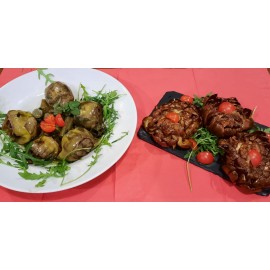Carciofi alla Romana VS Carciofi alla Giudia

Enzo Sisto 12 januari 2022

Carciofi alla Romana VS Carciofi alla Giudia
(Roman Style Artichokes VS Roman-Jewish Fried Artichokes)
Artichokes are one of the oldest food known to humans; the historians believe the artichokes originated in the Mediterranean countries, possibly Sicily or Tunisia and it was first recorded around 1400 in Italy. Ancient Greeks and Romans considered artichokes a delicacy and an aphrodisiac. They used to enjoy artichokes preserved in honey and vinegar, seasoned with cumin. In Ancient Greece, the artichokes were attributed to being effective in securing the birth of boys. After Rome fell, artichokes became rare but re-emerged during the Renaissance in 1466 when the Strozzi family brought them from Florence to Naples. Today, greatest producers of artichokes are still in Mediterranean and are still enjoyed in almost exactly the same way it was 600 years ago.
The question now is: are artichoke alla Romana and artichoke alla Giudia the same thing? Many tend to confuse the two recipes, but let's try to dispel any doubts: the artichokes alla Giudia are a delicious recipe to taste the fried artichoke, while the artichokes alla Romana are cooked in a pan.
What kind of Artichokes should you use?
The recipes is traditionally made with Roman cimaroli (or mammole) artichokes, which are large, round, tender and sometimes have a violet hue. These are the ideal ones to use for the recipes because they are plucked before their chokes have developed and they don’t sharp thorns.
If you’re not able to get your hands on Roman mammoles, don’t worry. You can get definitely use regular large artichokes – you’ll just need to remove the tough outer leaves, the choke, and trim down the leaves.
Carciofi alla Romana
Carciofi alla Romana is one of Italy's most famous artichoke recipe and it is a traditional Roman dish. It's made with little more than olive oil, wine, garlic, and herbs (mentuccia, a type of wild mint with a flavor resembling a cross between mint and oregano), but the result is gently cooked, supremely tender artichoke hearts in a fragrant bath of their own cooking juices. It’s a tasty side dish, usually served with meats.

How to Clean Artichokes
- Artichokes can darken your hands, so you can either wear gloves or rub your hands with lemon juice.
- Before you start to clean the artichokes, fill a large bowl with cold water, and the juice from one lemon.
- Then remove the tougher outer leaves, until you reach the more tender ones.
- Cut the top, removing about 2-3 cm off the top.
- Cut off the stem and clean with a sharp paring knife by removing the outer tough peel (place clean artichokes and stem in the bowl of water).
- Remove the choke either by slicing them in half and removing it with a sharp paring knife, or leaving them whole and using either a spoon or knife to remove it.
Ingredients
- 4 large or 12 small artichokes (1kg)
- 2 whole lemons (for maintaining artichokes' color)
- 1/4 cup (7g) minced flat-leaf parsley leaves
- 2 tablespoons minced fresh mint leaves
- 2 tablespoons minced fresh oregano leaves
- 3 medium cloves garlic, minced
- 1/4 cup (60ml) extra-virgin olive oil, plus more for drizzling
- 1/4 cup (60ml) dry white wine
- salt and black pepper
Preparation
The preparation of this exquisite recipe is rather simple. Roman style artichokes are cooked in a stainless saucepan with high sides, close to one another, so that the leaves do not open during cooking.
- In a small bowl, stir together parsley, mint, oregano, and garlic. Rub concave side of each artichoke heart with herb mixture, packing it into any leafy crevices. Set aside remaining herb mixture.
- Add olive oil and wine to a pot just large enough to hold all the artichokes closely side by side, so that they can sit flat with their stem sides up. Arrange artichokes in pot and season with salt and pepper.
- Bring pot to a simmer over medium-high heat, then lower heat to a bare simmer, cover, and cook until artichokes are fork-tender, 20 to 30 minutes (smaller artichokes may not take as long).
- Remove from heat and transfer artichokes to a platter, stem sides up. Drizzle with cooking juices, along with some fresh olive oil and a light sprinkling of reserved herb mixture. Serve warm or at room temperature.
Carciofi alla Giudia
The Jewish community began in Rome as early as 63 BC after the Romans invaded Judea and brought many of them back as slaves. Settling predominately on the east bank of the Tiber River, the walls (built in 1555) surrounding the ghetto kept them isolated for almost 300 years. The ghetto in Rome was one of the poorest in Italy.
The area is still known as the Jewish Ghetto and is a mostly Jewish quarter although the walls were demolished in 1888. An extraordinarily rich cusine grew up within its walls,
Carciofi alla Giudia (or Jewish-style artichokes) is a very old way of eating the vegetable.
The history that lies behind Carciofi alla Giudia dates back to the 16th Century when Jews were forced to follow strong restrictions, imposed by the Pope against them. Basically, they couldn’t have any kind of contact with Christians and, therefore, they established the Jewish ghetto in the city of Rome. Besides, two other Jewish communities moved to the Roman ghetto – whose popularity increased noteworthy – from Sicily and Spain. In this blended environment, Carciofi alla Romana recipe took finally shape. The Jewish housewives were the very first ones to prepare this dish and Jews used to eat it at the end of Yom Kippur’s celebration. “Alla Giudia” refers to “alla Giudea” (that means “something related to Jews”). The name was given by Romans, who fell immediately in love with the fried artichokes. There are other legends that surround Carciofi alla Giudia’s origin and none of them is more accurate than the others. Indeed, some believe these artichokes were eaten as a side-dish during the Jewish Easter day. Probably, neither of them is totally true or totally false, but the truth may be lying in between.

How to Clean Artichokes
The preparation of the Giudia artichokes requires some little attention.
1 Remove the outer leaves (the first 2-3 layers of leaves starting from the bottom) as they remain too hard even after cooking
2 Cut the stem 5 cm from the base of the artichoke. Don’t throw the stem away because it's delicious! Clean only the darker outside and fry it together with the artichokes!
Ingredients
- 4 artichokes
- 1 Squeezed Lemon
- Salt and pepper
- 1,5 lt of Extra Virgin Olive Oil
Preparation
- After cleaning the artichokes dip them in plenty of fresh water and lemon juice for about 10 minutes. Then drain and beat them together to spread the leaves
- Plunge the artichokes, with the stem upwards, in a high-sided pan filled with Extra Virgin Olive Oil
- Heated to a moderate heat. Let them cook for 15 minutes over a constant heat, up to the fork test: if it enters without difficulty up to the heart of the artichoke ... it's ready!
- Drain the artichokes and leave them for 15 minutes on absorbent paper (always with the stem up), so that they lose all the excess oil
- Turn the artichokes, gently mash them with a fork to give them the typical rose shape and add salt and pepper
- Sprinkle a little fresh water on the artichokes (they will be even more crunchy) and plunge them back into the oil brought to temperature again.
- Leave them on the stove for 1 minute, then drain them with a slotted spoon and serve them hot on the table!
The signs of a perfectly cooked Giudia artichoke lie in:
The first frying is finished when the color is slightly golden and, inside, the consistency is quite soft and about the outer leaves they must be dark brown in color and be crunchy like chips.
A special thanks to chef Alessandro Liberti and Mawi Pub&Restaurant

TIP:
In the Italian gastronomic tradition, one of the combinations that Italians love the most is artichokes with veal.
During the Christmas holidays, at home with mum, I enjoyed preparing Roman-style artichokes (my favorites). Being a laborious preparation, we decided to simplify the preparation of lunch by trying Casa Vercelli’s L’Arrosto Reale (I Pronti nel Sacco/ ready to cook).
Excellent and very tender meat. Tasty at the right point and very easy to prepare.
I am attaching photos of mamma's Roman-style artichokes with Casa Vercelli's royal roast.
https://www.ilvitellodicasavercelli.com


Gerelateerde blogs

Semi-wild breeding in the Limousin region
Enzo Sisto 6 november 2018
We have been visiting our virtuous breeders from the Limousin region in France.

Paris october 20th 2016
Enzo Sisto 20 oktober 2016
The SIAL in Paris has been a very important event for CHÂTEAU BOUCHER. From every European country everyone agrees with the new concept "La viande avec son vin".

Kick Off Dutch Foundation National BBQ Weeks
Enzo Sisto 1 februari 2020
We will do it again! The Dutch Foundation for The National BBQ Weeks give a great party to open the seasons 2020 in an appropriate sparkling way.